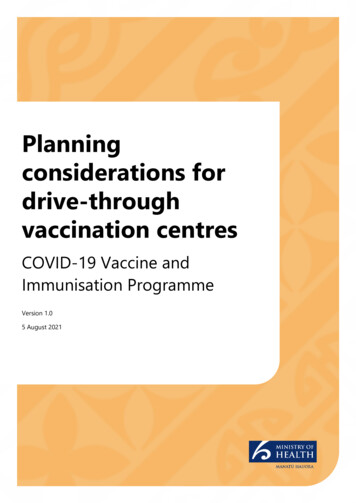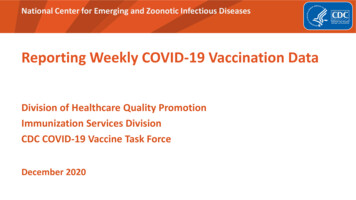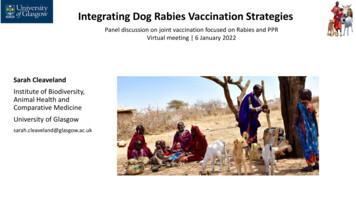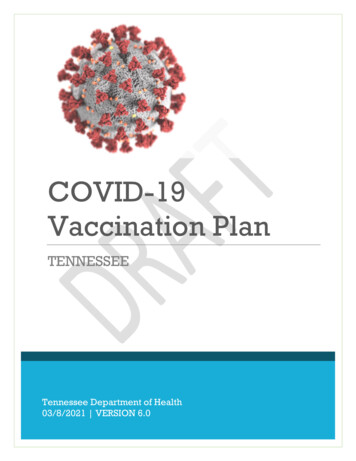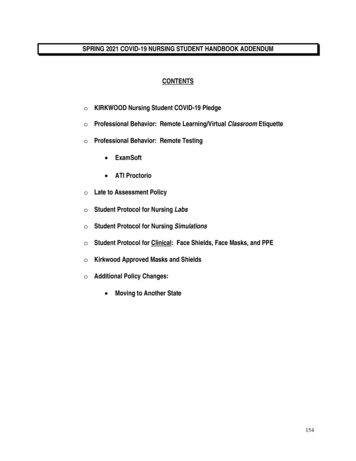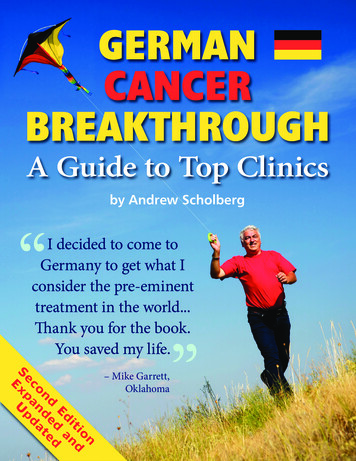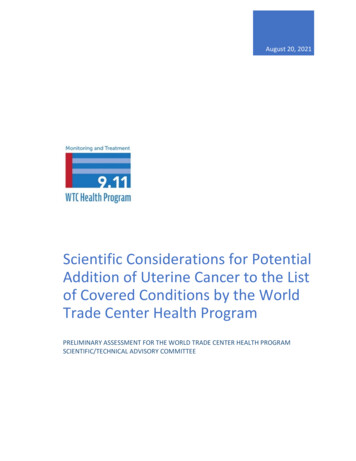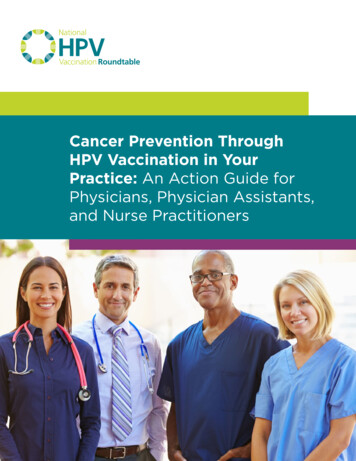
Transcription
Cancer Prevention ThroughHPV Vaccination in YourPractice: An Action Guide forPhysicians, Physician Assistants,and Nurse Practitioners
Cancer Prevention Through HPV Vaccination in Your Practice: An Action Guide for Physicians, Physician Assistants, and Nurse PractitionersACKNOWLEDGMENTSThe National HPV Vaccination Roundtable would like to thank allmembers of the Provider Training Task Group for participatingin the development of the six clinical action guides. Visit our websiteto view the entire suite of guides.1We offer sincere appreciation to the following individuals for their contributions to this guide:Margot Savoy, MD, MPH, FAAFPTodd Wolynn, MDMarie-Michèle Léger, MPH, PA-CSharon Perlman, DDS, MPHJennifer Nkonga, MSMarcie Fisher-Borne, PhD, MSW, MPHJoEllen Wolicki, BSN, RNJennifer Smith, PhD, MPHNoel Brewer, PhDCherie Ann Nathan, MD, FACSMichael Moore, MD, FACSDeanna Kepka, PhD, MPHGretchen Forsell, MPH, RD, LMNTLois Ramondetta, MDJennifer Young Pierce, MDJudy KleinAmanda Dempsey, MD, PhD, MPHAmerican Academy of Family PhysiciansAmerican Academy of PediatricsAmerican Academy of Physician AssistantsAmerican Association of Public Health DentistryAmerican Cancer SocietyAmerican Cancer SocietyCenters for Disease Control and PreventionCervical Cancer Free CoalitionUniversity of North CarolinaHead and Neck Cancer AllianceHead and Neck Cancer AllianceHuntsman Cancer Institute and Utah Cancer CenterNational Area Health Education Centers OrganizationM.D. Anderson Cancer CenterSociety of Gynecologic OncologyUNITY ConsortiumUniversity of ColoradoA Collaborative Project: The Clinician & Systems Action Guides are a collaborative project of the Provider Training Task Group of theNational HPV Vaccination Roundtable. Guides do not necessarily represent the views of all HPV Roundtable member organizations.Funding: Funding for this guide was made possible (in part) by the Centers for Disease Control and Prevention CooperativeAgreement grant number NH23IP922551-01, CFDA # 93.733. The content in this guide does not necessarily reflect the official policiesof the Department of Health and Human Services, nor does the mention of trade names, commercial practices, or organizations implyendorsement by the U.S. Government.Version 2.0 released September 2019.www.hpvroundtable.org2
3You have the power to make a lasting impact onhuman papillomavirus (HPV) vaccination and helpreduce the HPV cancer burden in your community.HPV cancer prevention starts with you.Your recommendation is the number one reason parents decide to vaccinate.The ProblemThe SolutionWith the HPV vaccine, you have the power toprevent cancer, yet HPV vaccination rates lagbehind those of other preteen vaccines. HPVcauses about 34,800 cases of cancer in men andwomen each year in the U.S.i Nearly all cases ofcervical cancer are caused by HPV, and the virusalso causes many cancers of the vagina, vulva,penis, anus, and oropharynx.iiThe HPV vaccine is cancer prevention. Boys andgirls should complete the HPV vaccine series at age11 or 12. The vaccine can be given starting as earlyas age 9. The HPV vaccine is more effective whengiven before age 13 to achieve the best immuneresponse, and it provides long-lasting protection.viHPV is linked with:91 63 70%of cervicaland analcancers%of penilecancers%of oropharynxcancersiiiThe HPV vaccine prevents infection by virus typesthat cause the vast majority of these cancers andgenital warts. In fact, HPV vaccination may help toeliminate cervical cancer, which takes the lives ofover 4,000 women in the U.S. each year.ivMissed opportunities for vaccination contributeto low HPV vaccination rates. A high-qualityrecommendation from a clinician is a powerfulmotivator of HPV vaccine acceptance, but manyclinicians deliver the HPV vaccine recommendationhesitantly, late, or not at all.vHPV vaccination works. Infections with the HPVtypes that cause the most HPV cancers and genitalwarts have dropped 71% among teen girls sincechildren first started getting the vaccine in 2006.viiGet more facts.271%drop in HPV infectionsamong teen girls since2006Make it your goal to identify and vaccinate everyage-eligible child in your care. Every member ofa practice plays a critical role in understandingand advocating for HPV vaccination as cancerprevention and should work together to reducemissed opportunities for vaccination.The biggest predictor of HPV vaccination uptakeis an effective recommendation from a clinician.Recent studies show that a patient who receives aprovider recommendation is 4–5 times more likelyto receive the HPV vaccine.viii The pages that followhave actions you can take to begin increasing HPVvaccination within your practice today.
4Actions At-A-GlanceVisit the action associated with each item below for detailed guidance.Evidence-based interventions:Presumptive recommendationsAction 1Electronic health record alertsAction 3Provider promptsAction 3Reminder and recall systemsAction 3Immunization information systemsAction 3, Action 5Standing ordersAction 4Other strategies you can use:Answer parents’ questionsAction 2Action 5Engage the entire clinic teamAction 4Know your vaccination ratesand monitor your successAction 5Create a pro-immunization environmentPatient Education ToolsIf you are reading a printed version of this guide, please see the Appendix for full links tohyperlinked words, as indicated by superscript numbers (e.g., Get more facts2).
Cancer Prevention Through HPV Vaccination in Your Practice: An Action Guide for Physicians, Physician Assistants, and Nurse PractitionersACTIONS YOU CANTAKE TO INCREASEHPV VACCINATIONAction 1 Make a presumptiverecommendation for cancerpreventionYour recommendation is powerful. Clinicianrecommendation is the number one reason parentschoose to vaccinate their children. Studies show that presumptive statements3—whichare brief statements that assume parents are readyto vaccinate—are more effective in improving HPVvaccination coverage than conversing with parents inan open-ended discussion.ix,x,xi CDC encourages that you also use a bundledapproach4 by recommending the HPV vaccine in thesame way and on the same day that you recommendother adolescent vaccines. For example,“Now that your son/daughter is 11, he/she is due for vaccinations to helpprotect against meningitis, HPV cancers,pertussis, and flu. We’ll give those shotsduring today’s visit.” Research shows that parents place just as muchvalue on the HPV vaccine as on other adolescentvaccines. They give the HPV vaccine a value of 9 out of 10—the same value they give to vaccinesthat protect against meningitis, hepatitis, pertussis,and influenza.xiiAction 2 Answer parents’ questionsParents look to you when it comes to their child’shealth. Answering parents’ questions effectively isan important step in building trust. After you make apresumptive recommendation, be prepared to answerparents’ questions. Inform your patients and theirparents about the importance of getting the HPVvaccine and let them know that the HPV vaccine iscancer prevention. Emphasize that the vaccine is safe, effective, andprevents cancer.5 Provide parents with fact sheets6 about the vaccineas needed.5 When counseling, be prepared to answer frequentlyasked questions7 from parents. For example: If parents question the need for the vaccine,you can say,“The HPV vaccine is important becauseit prevents infections that can causecancer. That’s why we need to start theshot series today.” If parents ask about the safety of the vaccine,you can say,“HPV vaccination is very safe. Likeany medication, vaccines can causeside effects, including pain, swelling,or redness where the shot was given.That’s normal for the HPV vaccine tooand should go away in a day or two.Sometimes kids faint after they getshots and they could be injured if theyfall from fainting. We’ll protect yourchild by having them stay seated afterthe shot.”
Cancer Prevention Through HPV Vaccination in Your Practice: An Action Guide for Physicians, Physician Assistants, and Nurse Practitioners Other techniques: Emphasize that adolescents in the targetedage range of 11–12 years have the most robustimmune response when vaccinated. Establish an opt-out policy8 rather than opt-in tonormalize HPV vaccination.Use personal examples if possible, for example,“I vaccinated my child at 11 to protecthim/her against HPV cancers.” Tips, scripts, and training resources for talkingwith parents about the HPV vaccine: CDC: #HowIRecommend YouTube Series9 National HPV Vaccination Roundtable:Elearning module: Increasing AdolescentImmunization Coverage10, 11 AAFP.org: Disease- and Population-SpecificImmunizations: Human PapillomavirusVaccine (HPV)12Action 3 Minimize missedopportunitiesOne of the most important ways to increase vaccinationin your practice is by using every opportunity toprovide vaccination and keep patients up to date on allimmunizations. When patients come in, check to see if they are duefor vaccinations. In most cases, patients can get theHPV vaccine during routine well-child, sick-child, orchronic care visits. Have your team plan ahead byrunning reports for patients who are due or overdue. Provide an opportunity for vaccination-only visits oroffer weekend clinic hours for vaccination. Promote a practice culture that is supportive ofimmunizations in order to protect every patient. Collaborate with your health information technology(IT) colleagues, office manager, and fellow cliniciansto establish effective strategies, such as: Create provider prompts.13 Establish electronic health record (EHR) alertsfor all age-eligible patients and set remindersin your EHR system for the second dose. Seeexamples here14 and here.15 Link to your state’s immunization informationsystem (IIS)16 to pull down/upload17 currentvaccination records. Review patient reminder and recall systems18 andconsider how to optimize via text messaging,mail, email, and/or phone calls.For older patients who were not vaccinated ontime (i.e., at ages 11–12), vaccination may be givenup to age 26 for females and males. Consult theImmunization Action Coalition’s Ask the Experts19HPV forum for guidance.6
Cancer Prevention Through HPV Vaccination in Your Practice: An Action Guide for Physicians, Physician Assistants, and Nurse PractitionersAction 4 Take the team approachEmpower every member of your team to become anHPV vaccine champion. A team-based approach iscrucial for making effective and lasting system changes. If your practice endorses standing orders,20 makesure they are being used. In some cases, patients canreceive the vaccination before you even enter theroom. If standing orders are not in place, the non-physicianmembers of your team can still make a difference.Arm colleagues with the right language to speakprofessionally and confidently about the vaccine,from the front desk to the exam room. Provide in-service training21 (see Chapter 3:Communicating With Parents About Vaccines) forthe entire practice on HPV vaccination and establishconsistent messaging to parents. Implement daily pre-clinic team meetings orhuddles22 to improve flow and quality of care. Ensurethat pre-visit planning or huddle discussions includea review of vaccination status. Be sure to assessvaccination status of drop-ins or walk-ins, too. Practice motivational interviewing23 techniquesto prepare for encounters with vaccine-hesitantpatients or parents.7 Additional resources to help your team understandthe vaccine: CDC: You Are the Key slides for clinicianaudiences–– Presentation24 CDC: HPV Vaccine Information Statement25 Inspire your team with stories of HPV cancersurvivors: National HPV Vaccination Roundtable: Survivorvideos26 MD Anderson Cancer Center: Blog post—Fromtonsil cancer survivor to HPV vaccine advocate27 Iowa Department of Health: HPV Cancer SurvivorStories Video28Find companion guides29 tailored to office teams,dental providers, nurses and medical assistants, andlarge and small health systems in the National HPVVaccination Roundtable’s Resource Library.30
Cancer Prevention Through HPV Vaccination in Your Practice: An Action Guide for Physicians, Physician Assistants, and Nurse PractitionersAction 5 Evaluate and sustainsuccessEstablishing systematic ways to regularly evaluate thesuccess of your efforts can help inform and maintainsuccessful vaccination strategies. Implement quality improvement (QI) strategies forincreasing immunization coverage rates: ACS: Steps for Increasing HPV Vaccination inYour Practice31 AAP: HPV Champion Toolkit: Making a Change inYour Office32 CDC: Quality Improvement and Evidence BasedInterventions33 Merck Vaccines: Health Care Provider-GeneratedIdeas for Process Improvement34 HPV IQ: Immunization Quality ImprovementTools35 NIPA: Improving HPV Immunization Rates inPractice-Based Settings Virtual Toolkit36 Know your rates of vaccination and how theycompare against your practice’s goals. Deputize team members to assist you with knowingyour actual vaccination rates and learning moreabout why some patients are behind on theirvaccines. Measure the number of HPV doses ordered andadministered37 in comparison with other adolescentvaccines. Ideally, providers should be ordering andadministering two doses of the HPV vaccine forevery one dose of Tdap. Engage with your colleagues who are responsiblefor monitoring quality metrics to determine currentpractice rates in comparison with state and nationalrates. Conduct Plan-Do-Study-Act38 cycles. Utilize IIS39 to inform vaccination coverageassessments, missed vaccination opportunities,invalid dose administration, and vaccinationcoverage disparities. IIS can also facilitate inventorymanagement and accountability.If your practice implements changes andsees positive results in your HPV vaccinationrates, let us know! Please send your story toHPV.Vaccination.Roundtable@cancer.org.Resource immunize.org/letter/recommend hpv 7)30072-1/pdfxiiAdapted from Healy et al. Vaccine. 2014; 32:579-584.8
Cancer Prevention Through HPV Vaccination in Your Practice: An Action Guide for Physicians, Physician Assistants, and Nurse PractitionersWork with your office team to create a proimmunization environment by displaying anddisseminating posters, brochures, flyers, andhandouts. Disseminate pro-immunization messagingvia your online channels, including patient portals,office website, and social media outlets.Materials you can use: Fact sheet: Diseases and the Vaccines thatPrevent Them: HPV40Are you also the HPVvaccination practice lead?Check out the companion guides45 for small privatepractices and large health systems for actions ontopics like evaluation, ordering, and implementingeffective QI strategies in your clinic. Flyers and posters: CDC’s Flyers and Posters forPreteens and Teens41YOU WOULD DOANYTHING TOPROTECT YOURCHILD FROMCANCER. BUTHAVE YOU DONEEVERYTHING?National HPV VaccinationRoundtable Resources:USTED HARÍA CUALQUIER COSAPARA PROTEGER A SU HIJO O HIJA DELCÁNCER. ¿Pero ha hecho todo?La vacuna contra el VPH previene el cáncer para niños y niñas. Sólo dosinyecciones a los 11–12 años de edad ofrecen una protección segura y duraderacontra las infecciones que causan el cáncer de VPH. Pídale al medico o enfermerade su hijo o hija que le pongan la vacuna contra el VPH.HPV vaccine is cancer prevention for boys and girls. Just two shots at ages 11–12provide safe and lasting protection against the infections that cause HPV cancer.Ask your child’s doctor or nurse for HPV vaccine. Elearning module: Increasing AdolescentImmunization Coverage46, 47 HPV survivor videos48vaccineis CANCER PREVENTIONvaccinewww.cdc.gov/HPVis CANCER PREVENTIONwww.cdc.gov/HPVJAN 2017 Short video: Protecting Your Patients fromHPV-Associated Cancer: What Providers Need toKnow about Oropharyngeal Cancer51 Evidence Summary on Clinical Communications58La vacuna contra el VPH previene el cáncer para niños y niñas. Sólo dosinyecciones a los 11–12 años de edad ofrecen una protección segura y duraderacontra las infecciones que causan el cáncer de VPH. Pídale al medico o enfermerade su hijo o hija que le pongan la vacuna contra el VPH.HPV vaccine is cancer prevention for boys and girls. Just two shots at ages 11–12provide safe and lasting protection against the infections that cause HPV cancer.Ask your child’s doctor or nurse for HPV vaccine.vaccine Middle School Health Parent Toolkit49 HPV Resource Library50USTED HARÍACUALQUIERCOSA PARAPROTEGER A SUHIJO O HIJA DELCÁNCER. ¿Peroha hecho todo?YOU WOULD DOANYTHING TOPROTECT YOURCHILD FROMCANCER. BUTHAVE YOU DONEEVERYTHING?is CANCER PREVENTIONENERO 2017vaccinewww.cdc.gov/HPVis CANCER PREVENTION Evidence Summary on ImprovingClinicalSystems59www.cdc.gov/HPVJAN 2017ENERO 2017 Industry handout: 4 Things a Parent Needs toKnow About Human Papillomavirus (HPV)42 Sample flyer: HPV Vaccine: Cancer Preventionfor Boys and Girls43 Social media messages: HPV Vaccine MythBusting for Health Care Providers SocialMedia Toolkit44HPV RoundtableMember Resources: ACS: Just the Facts52 ACS: Steps for Increasing HPV Vaccination inYour Practice53 AAFP: Immunizations website54 AAP: HPV Champion Toolkit55Follow the National HPVVaccination //www.facebook.com/groups/HPVCancerFreeFamily ACOG: HPV Vaccination Toolkit56 CDC: Clinician Fact Sheets and Guidance57 NCI: NCI-designated Cancer Centers UrgeHPV Vaccination for the Prevention of Cancer:Consensus Statement589
Cancer Prevention Through HPV Vaccination in Your Practice: An Action Guide for Physicians, Physician Assistants, and Nurse Practitioners10APPENDIX:MDs, NPs, & PAs1.Suite of guides: /2. Get more facts: for-providers.pdf3. Presumptive statements: y/2016/12/01/peds.2016-1764.full4. Bundled approach: munizations/disease-population/hpv.html23. Motivational interviewing: http://www.unity4teenvax.org/unity-projects/24. Presentations: https://www.cdc.gov/vaccines/ed/hpv/index.html25. HPV Vaccine Information Statement: s/hpv.html26. Survivor videos: https://www.youtube.com/playlist?list PLRu0uHzo7TdJzR83 C2ACchJlcFw-AbTc5. Safe, effective, and prevents cancer: y/2017/02/02/peds.20164187#xref-ref-14-127. Blog post––From tonsil cancer survivor to HPV vaccineadvocate: e-advocate.html6. Fact sheets: . HPV Cancer Survivor Stories Video: https://www.youtube.com/watch?v lwUPu4vS8OI&feature youtu.be7. Frequently asked questions: tml29. Companion guides: /8. Opt-out policy: http://www.immunize.org/catg.d/p4059.pdf30. Resource Library: http://hpvroundtable.org/resource-library/9. #HowIRecommend YouTube Series: https://www.youtube.com/results?search query %23howirecommend31. Steps for Increasing HPV Vaccination in Your easing-hpv-vaccination-in-practice.pdf10. As of 2019, this CME is no longer available. Please see http://hpvroundtable.org/resource-library/#filter .cme for CMEoptions.11. Non-credit version: https://www.youtube.com/watch?v pS-SZa3LY9k&feature youtu.be#0112. Disease- and Population-Specific Immunizations: HumanPapillomavirus Vaccine (HPV): AAFP.org: Disease- andPopulation-Specific Immunizations: Human PapillomavirusVaccine (HPV)13. Provider prompts: 66/14. Here: 1/ACS-HPV-NextGen-user-guide.pdf15. Here: es/EHRRelatedTools16. Immunization information system (IIS): -locate-records.html17. Pull down/upload: ves hpvtoolkit cleaning iis data 2015.pdf18. Reminder and recall systems: nt/Pages/reminder-recall-systems.aspx19. Ask the Experts: http://www.immunize.org/askexperts/experts hpv.asp20. Standing orders: http://www.immunize.org/catg.d/p3067.pdf21. In-service training: https://www.aap.org/en-us/Documents/immunizations training guide.pdf22. Huddles: https://www.aap.org/en-us/Documents/hpvtoolkit teamhuddle hpv 2015 may.pdf32. HPV Champion Toolkit: Making a Change in Your Office: kit/Pages/Making-a-Change-in-Your-Office.aspx33. Quality Improvement and Evidence Based reach-hcp/quality-improvement.html34. Health Care Provider-Generated Ideas for Process Improvement: es/HCPGeneratedIdeas35. Immunization Quality Improvement Tools: https://www.hpviq.org/36. NIPA: Improving HPV Immunization Rates in Practice-BasedSettings Virtual Toolkit. http://www.academicpeds.org/niPA/index.cfm?page quality-improvement37. Measure the number of HPV doses ordered and administered: ngrecommendation hpv psda 2015 may.pdf38. Plan-Do-Study-Act: dyActWorksheet.aspx39. IIS: html40. Diseases and the Vaccines that Prevent Them: HPV: html?CDCAA refVal iseases%2Fteen%2Fhpv.html41. CDC’s Flyers and Posters for Preteens and Teens: s.html42. 4 Things a Parent Needs to Know About Human Papilloma-
Cancer Prevention Through HPV Vaccination in Your Practice: An Action Guide for Physicians, Physician Assistants, and Nurse Practitionersvirus (HPV): https://www.hpv.com/static/pdf/MKHPV FACTSHEET.pdf43. HPV Vaccine: Cancer Prevention for Boys and Girls: P-Vaccine.pdf44. HPV Vaccine Myth Busting for Health Care Providers SocialMedia Toolkit: Toolkit%20FINAL.pdf45. Companion guides: /46. As of 2019, this CME is no longer available. Please see http://hpvroundtable.org/resource-library/#filter .cme for CMEoptions.47. Non-credit version: https://www.youtube.com/watch?v pS-SZa3LY9k&feature youtu.be#0148. HPV survivor videos: https://www.youtube.com/playlist?list PLRu0uHzo7TdJzR83 C2ACchJlcFw-AbTc49. Middle School Health Parent Toolkit: parents50. HPV Resource Library: http://hpvroundtable.org/resource-library/51. Protecting Your Patients from HPV-Associated Cancer:What Providers Need to Know about OropharyngealCancer: https://www.youtube.com/watch?v qnwb2-yyPU&list PLRu0uHzo7TdKdq1TstwyNbSn0KMI8L4--&index 1352. Just the Facts: for-providers.pdf53. Steps for Increasing HPV Vaccination in Your easing-hpv-vaccination-in-practice.pdf54. Immunizations website: unizations.html55. HPV Champion Toolkit: kit/Pages/HPV-Champion-Toolkit.aspx56. HPV Vaccination Toolkit: http://immunizationforwomen.org/toolkit/hpv57. Clinician Fact Sheets and Guidance: ml58. NCI-designated Cancer Centers Urge HPV Vaccination forthe Prevention of Cancer: Consensus Statement: i hpv consensus statement 012716.pdf11
Use personal examples if possible, for example, "I vaccinated my child at 11 to protect him/her against HPV cancers." Tips, scripts, and training resources for talking with parents about the HPV vaccine: CDC: #HowIRecommend YouTube Series9 National HPV Vaccination Roundtable: Elearning module: Increasing Adolescent
